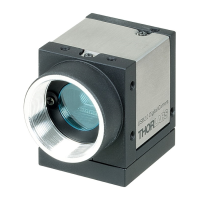© 2013 Thorlabs GmbH
2 Camera Basics
39
2.5 Digitizing Images
Characteristics and LUT
Bit depth and digital contrast adjustment
2.5.1 Characteristics and LUT
When perceiving or imaging a scene, the form of the imaging characteristic is crucial for displaying the differences
in brightness. With image processing (e.g. applications such as edge detection and character recognition), linear
characteristics are generally required. The human eye, on the other hand, perceives differences in brightness
based on a logarithmic characteristic, which often approximates a gamma characteristic in practice. All three forms
will be shown in the following.
Linear characteristic
If a system (e.g. a camera with a conventional CCD sensor) yields double the output value for double the
brightness, the system features a linear characteristic:
Imaging with linear characteristic
Gamma characteristic
Gamma characteristics (or gamma curves) are named after the Greek formula symbol γ. Gamma curves are
power functions of the form
and are often used in photography or image display on computer screens. A gamma value of 1 generates a linear
characteristic again. A curve with the value γ = 2.2 used for computer screens is shown in the figure below.
Imaging with gamma characteristic
Such a gamma characteristic brightens dark areas of an image, which corresponds more to the perception of the
human eye. In light areas of an image, the differences in brightness are condensed for this.
39
41

